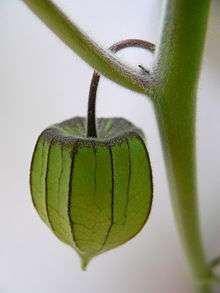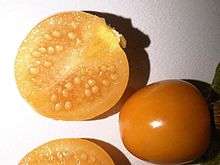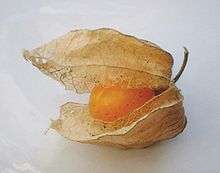Physalis peruviana
| Cape gooseberry | |
|---|---|
 | |
| Cape gooseberry flower | |
| Scientific classification | |
| Kingdom: | Plantae |
| (unranked): | Angiosperms |
| (unranked): | Eudicots |
| (unranked): | Asterids |
| Order: | Solanales |
| Family: | Solanaceae |
| Genus: | Physalis |
| Species: | P. peruviana |
| Binomial name | |
| Physalis peruviana L. | |
| Synonyms[1] | |
| |
Physalis peruviana, a plant species of the genus Physalis, is originally from Peru and Chile. The plant and its fruit are most commonly known as Cape gooseberry (South Africa, UK, Australia, New Zealand), or Physalis.[2][3]
It is indigenous to western South America, but has been cultivated in England since the late 18th century and in South Africa in the region of the Cape of Good Hope since at least the start of the 19th century.
Description

Physalis peruviana is closely related to the tomatillo and to the Chinese lantern, also members of the genus Physalis.[2] As a member of the plant family Solanaceae, it is more distantly related to a large number of edible plants, including tomato, eggplant, potato and other members of the nightshades.[2] Despite its name, it is not closely related to the cherry, Ribes gooseberry, Indian gooseberry, or Chinese gooseberry.
The fruit is a smooth berry, resembling a miniature, spherical, yellow tomato. Removed from its bladder-like calyx, it is about the size of a marble, about 1–2 cm in diameter. Like a tomato, it contains numerous small seeds. It is bright yellow to orange in color, and it is sweet when ripe, with a characteristic, mildly tart flavor, making it ideal for snacks, pies, or jams.[2] It is relished in salads and fruit salads, sometimes combined with avocado. Also, because of the fruit's decorative appearance, it is popular in restaurants as an exotic garnish for desserts.
A prominent feature is the inflated, papery calyx enclosing each berry. The calyx is accrescent until the fruit is fully grown; at first it is of normal size, but after the petals fall it continues to grow until it forms a protective cover around the growing fruit. If the fruit is left inside the intact calyx husks, its shelf life at room temperature is about 30–45 days.
Geographic and cultivation origins
Native to high-altitude, tropical Chile and Peru,[2] where the fruits grow wild, physalis is locally eaten and frequently sold in markets. Only recently has the plant become an important crop; it has been widely introduced into cultivation in other tropical, subtropical and even temperate areas.

The plant was grown by early settlers of the Cape of Good Hope before 1807. It is not clear whether it was grown there before its introduction to England, but sources since the mid-19th century attribute the common name, "Cape gooseberry" to this fact.[4][5] A popular suggestion is that the name properly refers to the calyx surrounding the fruit like a cape. This seems however, to be an example of folk etymology or false etymology, because it does not appear in publications earlier than the mid 20th century.
Not long after its introduction to South Africa, Physalis peruviana was introduced into Australia, New Zealand, and various Pacific islands.[2]
In South Africa, it is commercially cultivated; canned fruits and jam are common, often exported. It is also cultivated and naturalized on a small scale in Gabon and other parts of Central Africa.
Soon after its adoption in the Cape of Good Hope, it was carried to Australia, where it was one of the few fresh fruits of the early settlers in New South Wales. It is also favored in New Zealand, where it is said "the housewife is sometimes embarrassed by the quantity of berries in the garden",[2] and government agencies promote increased culinary use. It is grown in India where it is called ras bhari.
Marketing
Physalis peruviana (from South America) fruits are marketed in the United States most commonly as goldenberry and sometimes Pichuberry, named after Machu Picchu in order to associate the fruit with its origin in Peru and address the fact that this fruit is actually not a gooseberry as the name Cape gooseberry implies.[6][7]
In Britain, the fresh fruit is usually sold as Physalis, but the dried fruit is sold as goldenberry.
Regional names
The Cape gooseberry is also grown in northeastern China Heilongjiang Province as a seasonal fruit harvested in late August through September. In Chinese pinyin, the fruit is informally referred to as gu niao or mao suan jiang.
It is grown in Thailand, particularly on Doi Inthanon, and in Egypt, where it is known locally as harankash or as is-sitt il-mistahiya (the shy woman), a reference to the papery sheath.
Other regional names include uchuva (Colombia), rasbhari (India), Inca berry, Aztec berry, golden berry, giant ground cherry, African ground cherry, Peruvian groundcherry, Peruvian cherry, amour en cage (France, French for "love in a cage"),[8] and altın çilek (Turkey).
Nutrients and basic research

| Nutritional value per 100 g (3.5 oz) | |
|---|---|
| Energy | 222 kJ (53 kcal) |
|
11.2 g | |
|
0.7 g | |
|
1.9 g | |
| Vitamins | |
| Vitamin A equiv. |
(5%) 36 μg |
| Thiamine (B1) |
(10%) 0.11 mg |
| Riboflavin (B2) |
(3%) 0.04 mg |
| Niacin (B3) |
(19%) 2.8 mg |
| Vitamin C |
(13%) 11 mg |
| Minerals | |
| Calcium |
(1%) 9 mg |
| Iron |
(8%) 1 mg |
| Phosphorus |
(6%) 40 mg |
|
| |
| |
|
Percentages are roughly approximated using US recommendations for adults. Source: USDA Nutrient Database | |
According to nutrient analyses by the USDA, a 100 g serving of Cape gooseberries is low in calories (53 kcal) and contains moderate levels of vitamin C, thiamin and niacin, while other nutrients are negligible (right table).[9] Analyses of oil from different berry components, primarily its seeds, showed that linoleic acid and oleic acid were the main fatty acids, beta-sitosterol and campesterol as principal phytosterols, and the oil contained vitamin K and beta-carotene.[10]
Basic research on Cape gooseberry includes studies on polyphenols and/or carotenoids.[11] Phenolic content varies in Cape gooseberries according to type of cultivar and time of fruit ripening.[12]
Pests and diseases
In South Africa, cutworms are the most important of the many insect pests that attack the cape gooseberry in seedbeds; red spiders after plants have been established in the field; and the potato tuber moth if the cape gooseberry is in the vicinity of potato fields. Hares damage young plants, and birds eat the fruits if not repelled. In India, mites may cause defoliation. In Jamaica, the leaves were suddenly riddled by what were apparently flea beetles. In the Bahamas, whitefly attacks on the very young plants and flea beetles on the flowering plants required control.[2]
In South Africa, the most troublesome diseases are powdery mildew and soft brown scale. The plants are prone to root rots and viruses if on poorly drained soil or if carried over to a second year. Therefore, farmers favor biennial plantings. Bacterial leaf spot (Xanthomonas spp.) occurs in Queensland. A strain of tobacco mosaic virus may affect plants in India.[2] In New Zealand, plants can be infected by Candidatus liberibacter subsp. solanacearum.[13]
See also
- Physalis pubescens (a closely related species, sprouts are noticeably less hairy)
References
- ↑ "The Plant List: A Working List of All Plant Species". Retrieved 14 December 2014.
- 1 2 3 4 5 6 7 8 9 Morton JF (1987). "Cape gooseberry, Physalis peruviana L. in Fruits of Warm Climates". Purdue University, Center for New Crops & Plant Products.
- ↑ Ad Hoc Panel of the Advisory Committee on Technology Innovation, Board on Science and Technology for International Development, National Research Council (1989). Lost Crops of the Incas: Little-Known Plants of the Andes with Promise for Worldwide Cultivation. Washington, D.C.: The National Academies Press. pp. 249–50. ISBN 978-0-309-07461-2.
- ↑ von Mueller, Ferdinand. Select Extra-Tropical Plants Readily Eligible For Industrial Culture Or Naturalization, With Indications Of Their Native Countries And Some Of Their Uses. Detroit, Michigan: G.S. Davis, 1884. Page 229. May be obtained from Amazon or downloaded from:https://archive.org/details/selectextratropi00muel
- ↑ Loudon, Jane Wells. Botany for Ladies, Or, a Popular Introduction to the Natural System of Plants. Pub: J. Murray (1842)
- ↑ Galarza, Daniella. "This Goose(berry) is Cooked: Let's Talk About the Pichuberry". Los Angeles Magazine. Retrieved 19 April 2014.
- ↑ Borowitz, Adam. "Pichuberries (June 21, 2012)". Article. Tucson Weekly. Retrieved 6 May 2014.(A package purchased in May 2014 was labelled "Product of Colombia")
- ↑ "Semer et planter le physalis ou amour en cage". Retrieved 6 May 2014.French: amour en cage English: Love in a cage
- ↑ "Groundcherries, (cape-gooseberries or poha), raw, 100 g, USDA Nutrient Database, version SR-21". Nutritiondata.com. Conde Nast. 2014. Retrieved 7 May 2014.
- ↑ Ramadan MF, Mörsel JT (2003). "Oil goldenberry (Physalis peruviana L.)". J Agric Food Chem. 51 (4): 969–74. doi:10.1021/jf020778z. PMID 12568557.
- ↑ Wu, SJ; Tsai JY; Chang SP; Lin DL; Wang SS; Huang SN; Ng LT (2006). "Supercritical carbon dioxide extract exhibits enhanced antioxidant and anti-inflammatory activities of Physalis peruviana". J Ethnopharmacol. 108 (3): 407–13. doi:10.1016/j.jep.2006.05.027. PMID 16820275.
- ↑ Bravo K, Sepulveda-Ortega S, Lara-Guzman O, Navas-Arboleda AA, Osorio E (2015). "Influence of cultivar and ripening time on bioactive compounds and antioxidant properties in Cape gooseberry (Physalis peruviana L.)". J Sci Food Agric. 95 (7): 1562–9. doi:10.1002/jsfa.6866. PMID 25131258.
- ↑ Liefting, L. W.; L. I. Ward; J. B. Shiller; G. R. G. Clover (2008). "A New 'Candidatus Liberibacter' Species in Solanum betaceum (Tamarillo) and Physalis peruviana (Cape Gooseberry) in New Zealand". Plant Disease. 92 (11): 1588. doi:10.1094/PDIS-92-11-1588B. Retrieved 2009-01-01.
External links
-
 Media related to Physalis peruviana (category) at Wikimedia Commons
Media related to Physalis peruviana (category) at Wikimedia Commons -
 Data related to Physalis peruviana at Wikispecies
Data related to Physalis peruviana at Wikispecies